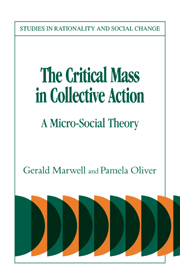Book contents
- Frontmatter
- Contents
- PREFACE
- ACKNOWLEDGMENTS
- 1 The critical mass and the problem of collective action
- 2 Building blocks: goods, groups, and processes
- 3 The paradox of group size
- 4 The dynamics of production functions
- 5 Social networks: density, centralization, and cliques
- 6 Selectivity in social networks
- 7 Reach and selectivity as strategies of recruitment
- 8 Unfinished business
- REFERENCES
- NAME INDEX
- SUBJECT INDEX
7 - Reach and selectivity as strategies of recruitment
Published online by Cambridge University Press: 19 March 2010
- Frontmatter
- Contents
- PREFACE
- ACKNOWLEDGMENTS
- 1 The critical mass and the problem of collective action
- 2 Building blocks: goods, groups, and processes
- 3 The paradox of group size
- 4 The dynamics of production functions
- 5 Social networks: density, centralization, and cliques
- 6 Selectivity in social networks
- 7 Reach and selectivity as strategies of recruitment
- 8 Unfinished business
- REFERENCES
- NAME INDEX
- SUBJECT INDEX
Summary
Organizers typically care a great deal about the collective good and are willing to spend substantial portions of their personal resources to help get it. However, they have limited resources and time and cannot do everything at once. Thus, they have to think strategically about how they will go about recruiting others to participate. In Chapter 6, we considered two models for the effects of information on the selectivity of the recruitment process. In the present chapter we discuss the general idea of selectivity using a different mathematical strategy and explore the trade-offs organizers make between the quality and quantity of their recruits.
The existing literature focuses on two simple but related distinctions regarding recruitment strategies. The first is between strategies that concentrate on the social networks of members of the movement in order to recruit and strategies that use more impersonal methods (Gerlach and Hine 1970; Oberschall 1973; John Wilson 1973; Useem 1975; Tilly 1978; Snow, Zurcher, and Ekland-Olson 1980). The second distinction is between strategies that result in the recruitment of solidary blocs of people, such as church groups, and those that result in the recruitment of isolated individuals (J. Freeman 1973; Oberschall 1973; Fireman and Gamson 1979; Zald and McCarthy 1979; Jenkins 1982).
In this chapter we make the somewhat different, although related, analytic distinction between reach and selectivity. The reach of a recruitment strategy is the number of people who are contacted; while the selectivity of a strategy is the extent to which it contacts the portion or subgroup of the whole interest group that is most likely to make substantial contributions to the cause.
- Type
- Chapter
- Information
- The Critical Mass in Collective Action , pp. 157 - 179Publisher: Cambridge University PressPrint publication year: 1993



